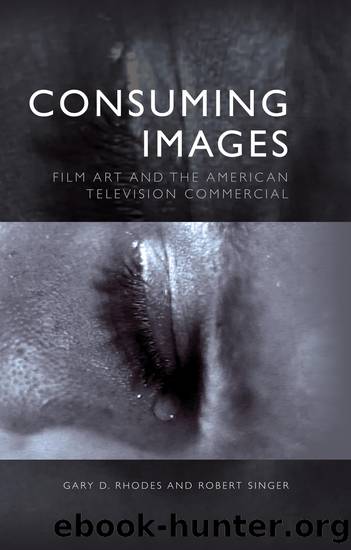Consuming Images by Rhodes Gary D.;Singer Robert;

Author:Rhodes, Gary D.;Singer, Robert;
Language: eng
Format: epub
Publisher: Edinburgh University Press
Figure 4.3âWhen Thereâs No Man Around (circa 1966)
It was not until Richard Avedonâs four spots for Calvin Kleinâs Obsession in 1985 that black and white became a major trend in TV commercial production. They featured black-and-white footage bracketing a narrative otherwise told in color. Academy Award recipient Nestor Almendros, cinematographer of Days of Heaven (Terrence Malick, 1978), Kramer vs. Kramer (Robert Benton, 1979), and Sophieâs Choice (Alan J. Pakula, 1982), shot the commercials.16 The following year, a commercial for the San Francisco Examiner depicted William Randolph Hearst III in the âstark black and white style of Citizen Kane [Orson Welles, 1941].â17 By 1987, Advertising Age observed the growing number of commercials that were largely or wholly filmed in black and white.18 Most notable among them was perhaps Nikeâs Revolution (1987), directed by Paula Greif and Peter Kagan. The two used Super 8mm black-and-white reversal stock, a daring move for any mainstream film in an era before Oliver Stoneâs JFK (1991).
In 1988, BBDO relied on the âtrendy black-and-white formatâ for a Dodge automobile commercial in an effort to stand out, to âbreak through ad clutter.â19 Paul Grainge writes:
In general, monochrome experienced a resurgence in brand advertising during the 1980s and 1990s by global multinationals such as Nike, Coca-Cola, and Calvin Klein .â.â. [M]onochrome became a strategic promotional mode, used both for its connotations of time and its association with artistry and style. In the fashion industry, in particular, black and white was used as a signature of designer legitimacy and high-street chic, advertising anything from the chiaroscuro elegance of Giorgio Armani to the sport/street styles of Adidas.20
The use of black and white in commercials became pronounced enough to inspire various parodies of the same, such as Compulsion by Calvin Kleen on Saturday Night Live in 1987. And its presence has continued in the twenty-first century.
As with their feature-film forebears, these commercials have relied on black and white to create particular moods, which range from nostalgia (as in David Simpsonâs Twilight Zone-style commercial for Arbyâs in 1989) and humor (as in Pepsiâs 1996 commercial Security Camera) to romance (as in Lee Jeansâ commercial for Riveted Flares in 1997).21 All of these elements mark Martin Scorseseâs Dolce & Gabbana commercial Street of Dreams (2013), starring Scarlett Johansson and Matthew McConaughey. And then there is the depiction of sex, which Cross Verve fountain pens used in a 2003 spot featuring ânear-nakedâ talent. Advertising Age responded âHubba hubba!â but told readers, âDonât worry. Itâs not pornography. Itâs shot in black-and-white, so obviously its art.â22
By contrast, other ads have relied on black and white to convey fear or revulsion. In 1988, the GOP ran a spot entitled I Remember You that featured âstarkâ black-and-white images of America during the Carter administration to frighten voters into electing Republicans.23 And then there is David Lynchâs Rats (1988), sponsored by the nonprofit organization We Care About New York, Inc. Its narrative preaches against littering by linking the same to the cityâs rat population. Horrifying closeups of a ratâs tail, paws, face, and mouth unfold in slow motion.
Download
This site does not store any files on its server. We only index and link to content provided by other sites. Please contact the content providers to delete copyright contents if any and email us, we'll remove relevant links or contents immediately.
| Direction & Production | Reference |
The Kite Runner by Khaled Hosseini(4944)
Gerald's Game by Stephen King(4366)
Dialogue by Robert McKee(4156)
The Perils of Being Moderately Famous by Soha Ali Khan(4061)
Story: Substance, Structure, Style and the Principles of Screenwriting by Robert McKee(3325)
The 101 Dalmatians by Dodie Smith(3296)
The Pixar Touch by David A. Price(3202)
Confessions of a Video Vixen by Karrine Steffans(3098)
How Music Works by David Byrne(2958)
Fantastic Beasts: The Crimes of Grindelwald by J. K. Rowling(2837)
Slugfest by Reed Tucker(2796)
Harry Potter 4 - Harry Potter and The Goblet of Fire by J.K.Rowling(2796)
The Mental Game of Writing: How to Overcome Obstacles, Stay Creative and Productive, and Free Your Mind for Success by James Scott Bell(2763)
4 - Harry Potter and the Goblet of Fire by J.K. Rowling(2526)
Screenplay: The Foundations of Screenwriting by Syd Field(2428)
Scandals of Classic Hollywood: Sex, Deviance, and Drama from the Golden Age of American Cinema by Anne Helen Petersen(2391)
Wildflower by Drew Barrymore(2378)
The Complete H. P. Lovecraft Reader by H.P. Lovecraft(2366)
Casting Might-Have-Beens: A Film by Film Directory of Actors Considered for Roles Given to Others by Mell Eila(2300)
